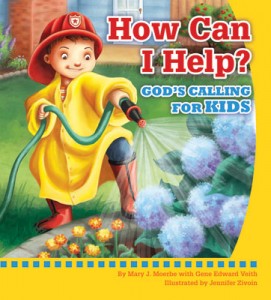 A review of How Can I Help? God’s Calling for Kids by Mary J. Moerbe, illustrated by Jennifer Zivoin. (Concordia, 2014)
A review of How Can I Help? God’s Calling for Kids by Mary J. Moerbe, illustrated by Jennifer Zivoin. (Concordia, 2014)
As a Christian parent I’m often thinking about how to communicate the glorious truths of the Gospel to my young children. How to explain simply, but not simplistically, something of the majesty and holiness of God, the wonder of the forgiveness, life, hope and joy found in Christ.
But what about teaching children what the Bible has to say about work? Have you ever considered how you might help them to understand this? What would a theology of work, aimed at children, look like?
This is precisely what How Can I Help? God’s Calling for Kids sets out to do. In recent years there has been a proliferation of books about faith and work. But I can’t think of any other like this that seeks to help children understand the connection between the Christian faith and our daily work. Written by Mary J. Moerbe (the daughter of Gene Edward Veith, author of God at Work), this short book aims to outline Luther’s doctrine of vocation, but for kids.
It opens with a lovely introduction for parents written by Veith, briefly explaining how Luther understood vocation and calling. Luther railed against the notion that only those doing the work of the church had a vocational calling from God. Rather, “Luther said that a little boy doing what his parents say or a little girl doing her chores is doing a holier work than that of the strictest monk or nuns”. And what is common to the vocation of all of us is that we are to help others through our daily labour, regardless of age. “The purpose of every vocation is to love and serve our neighbours”.
It is this principle that Moerbe fleshes out in How Can I Help? She starts with the greatest helper of all, God, but explains that He has also tasked us with the job of helping others. For example, mums and dads help their kids by preparing food for them to eat. And each day kids have opportunities to help others, including helping their parents by obeying them (a message I suspect all parents will be happy with!)
The central message comes at the end when Moerbe shows how this idea of helping connects with the paid and unpaid work that adults do: “When I grow up, I will help others on a farm or in an office or wherever I will be. I can get married and have children and I will help them too!”
The book then closes by reminding kids of the greatest helper of all, Jesus, with the caveat that “Jesus is much more than a helper. He is my Saviour”.
At times the writing felt a bit clunky and the ideas forced, like Moerbe was having to try hard to explain the concept in simple terms and still keep it interesting. But then again, it’s no easy task making Luther’s doctrine of vocation relevant and understandable to children!
As I read through How Can I Help?, it did make me wonder if there would be less confusion amongst adults about the relationship between Christian faith and work if we started teaching it much earlier. That is, if we didn’t wait until people reached the workplace before they began thinking about it. This book begins that task wonderfully and is worth having in any family library as you seek to help your children understand God’s purposes for our daily work.
Andrew Laird is the director of Life@Work, an initiative of Melbourne City Bible Forum, which aims to help Christians think through how their faith connects with their work.
Email This Story
Why not send this to a friend?




